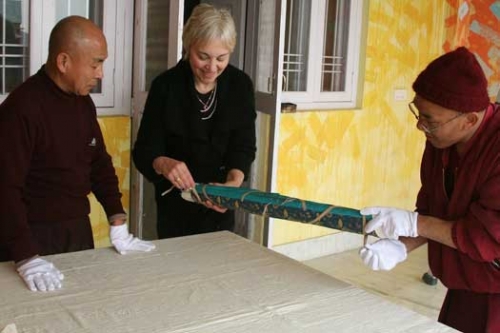This guest blogpost comes our way from Ann Shaftel, a Preservation Consultant and Conservator for museums and monastic collections worldwide. Ann is a Fellow of the American Institute for Conservation, a Fellow of International Institute for Conservation, and is recognized by the Canadian Association of Professional Conservators. She holds an MS degree in Art Conservation, an MA degree in Museum Studies and Asian Art History, has worked and studied at the ICCROM Centre in Rome, and trained in traditional thangka painting. Ann’s clients include museums, governments, universities, and Buddhist monasteries worldwide.
My friends say that I have the best job in the world: traveling to monasteries in the Himalayan region and advising teachers on the preservation of their lineage treasures: thangkas, rupas, texts, dance costumes, robes, wall paintings etc. And they like to visit while I work “behind the scenes” in the storage rooms of major museums, and presenting workshops to museum staff on the preservation of Himalayan Buddhist art collections.
After the Sixteenth Karmapa told me “preserving thangkas and rupas is your dharma work for this lifetime” I sought the advice of Chogyam Trungpa Rinpoche, himself a trained thangka painter. Trungpa Rinpoche advised me to return to graduate school and reach the highest levels of training in this work, to strive for the highest professional standing and the most informed methods. He also advised that I not work full time in one major museum, but to work for monasteries, dharma centers and museums worldwide.
Art Conservation is based on both up-to-date science and respect for cultures. Preservation efforts can make the difference between a thangka lasting for five more years, or five more decades or centuries, for future generations.
For a monk/caretaker in a remote monastery, or a dharma student in Australia, Brazil, California or Denmark, many of the same, simple preservation principles apply for the care and handling of their treasures.
Thangkas are a good example. Thangka owners contact me every day, concerned about the deteriorating conditions of their thangka treasures. Thangkas damage easily: Western museums have restored thangkas since explorers first donated them in the 1800’s. After the thangkas leave their home monasteries and move to museums, private collections, art dealers’ showrooms, and western monasteries, their fate changes. Although guidelines can be offered for the preservation of these complicated composite objects, a restoration procedure preferred by a current owner may conflict with traditional values and procedures. Ethical, cultural and religious considerations must be considered while working with thangkas in any capacity.
A changing culture can be documented through the preservation of its traditional artifacts. Time moves on with changes in the available painting media and with the influence of outside cultural influences. Many traditional, old thangkas are deteriorating in Himalayan monasteries while new art forms, still referred to as thangkas, begin to carry the traditional religious/cultural message of a sacred art.
There are many dilemmas in thangka care. Informed decisions can be made with an understanding of how thangkas are traditionally created and utilized; and how damage you might see in a thangka today may have resulted from methods used in its creation, factors in traditional use, and in the later processes of art collecting, display, handling and restoration procedures.
Please write with any questions concerning the preservation of sacred art in your care!

Ann Shaftel in Bhutan, 2011

Ann at The University of Michigan Museum of Anthropology 2010

Working in Bir, Himachal Pradesh, India on safe rolling techniques for thangkas.
Thank you for subscribing to Tricycle! As a nonprofit, we depend on readers like you to keep Buddhist teachings and practices widely available.